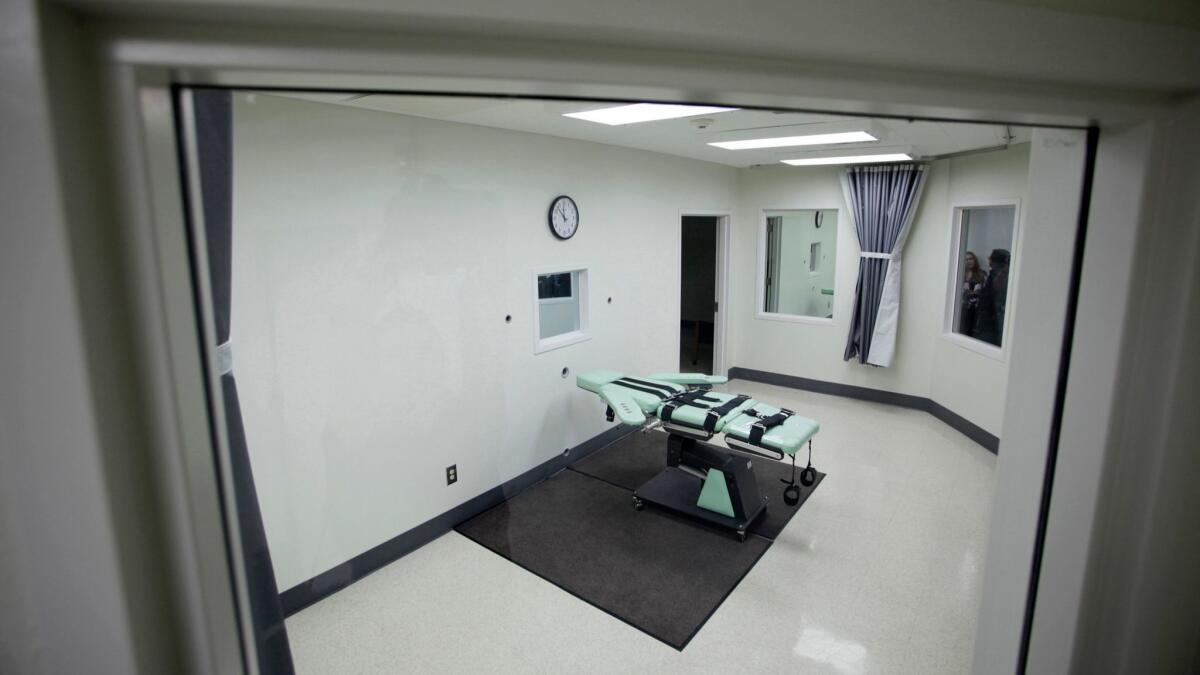California’s new lethal injection plan already faces hurdles: Drugs barred from import or execution use

California moved a step closer to resuming lethal injections this week but still faces significant hurdles before inmates can be executed.
The Department of Corrections and Rehabilitation has unveiled a revised single-drug method of execution, allowing the state to use either pentobarbital or thiopental in a single infusion to put condemned inmates to death.
But the barbiturates are extremely difficult to obtain, lawyers on both sides of the death penalty debate said Tuesday, and their lack of availability could eventually doom plans to restart the death chamber at San Quentin State Prison.
The U.S. Food and Drug Administration has barred the import of thiopental, and the manufacturer of pentobarbital has prohibited the drug from being used in executions.
“The state cannot lawfully procure either of those drugs through a reputable channel,” said Ana Zamora, criminal justice director of the American Civil Liberties Union of Northern California.
The protocol allows for compounding pharmacies to make the drugs, but the state would need to import the necessary ingredients, said Kent Scheidegger, legal director of the pro-death penalty Criminal Justice Legal Foundation. “That is a problem.”
Terry Thornton, a spokeswoman for the corrections department, said she couldn’t comment on whether the drugs might be impossible to obtain.
“I can tell you that CDCR will comply with all applicable laws in the procurement of the lethal injection chemicals,” she said.
Several states have had to place holds on executions because of the difficulty of obtaining the needed drugs.
The shortage stems in part from pressure placed by death penalty opponents on manufacturers to prevent their products from being used in executions.
A previous lethal injection protocol proposed by California would have allowed officials to choose one of four different drugs for executions. But the ACLU strongly opposed the use of two of them, arguing they had never been used in an execution.
The state later withdrew those two drugs from its proposed protocol, saying it was questionable whether the chemicals could be obtained in a form needed for lethal injection.
Scheidegger said that was a mistake. “Every drug has to have a first use,” he said.
Even if compounding pharmacies could obtain the ingredients needed for the two drugs now permitted, there is no guarantee that the chemicals would be processed correctly, Zamora said.
She said drugs made by compounding pharmacies have led to botched executions in other states.
“Will they engage in a covert mission to swap drugs with other states?” she asked. “We have a lot of concerns about how they are going to legally procure these two drugs.”
She said the new protocol was essentially the same one rejected last year by a state law office before Proposition 66 became final.
It “contains a lot of the same problems — legal and practical problems — that the courts have been pointing to for years and years,” she said.
California has the largest death row in the nation, with nearly 750 condemned inmates.
Scheidegger and his group joined prosecutors in winning passage of Proposition 66 in 2016, which was intended to speed up executions. The measure was immediately challenged.
The California Supreme Court eventually upheld most of it, including a provision that exempted lethal injection protocols from a state administrative procedures law.
As a result, the new protocol should become final in a month or two, Scheidegger said.
The next step for death penalty supporters will be to try to remove court injunctions blocking executions.
Scheidegger’s group has moved to end an injunction issued by a state court, arguing it was based on the law prior to Proposition 66. The measure, in fact, was written in part to get around that injunction.
He said efforts also are being made to end the federal injunction, issued in 2006 after a judge found the state’s former three-drug method of execution unconstitutional.
“None of [the injunctions] have any legal basis, but it does take time to get these hurdles removed by the courts,” Scheidegger said.
He said he was hopeful the injunctions could be removed by the end of the year.
U.S. District Court Judge Richard Seeborg, an Obama appointee presiding over the Northern California lethal injection case, will eventually have to determine whether the new protocol violates the Constitution’s ban on cruel and unusual punishment.
About 18 inmates have exhausted their appeals and could be executed relatively swiftly if the court battles were resolved and the state obtained the needed drugs.
Because of all the hurdles, though, Gov. Jerry Brown could leave office next year without having to preside over a single execution.
Brown is known to personally oppose capital punishment, but he took no position on ballot measures in recent years that would have ended the death penalty in California.
California’s Constitution also limits his power to commute death sentences to life without parole.
He would need the support of four of seven justices on the California Supreme Court to commute death sentences of inmates who committed multiple felonies.
At least half of the state’s death row inmates have multiple felonies on their records, lawyers said.
Ronald Reagan was the last California governor to commute a death sentence, deciding in 1967 to move Calvin Thomas off death row because Thomas had serious brain damage.
Former Gov. Pat Brown, Jerry Brown’s father, commuted capital sentences of 20 inmates and oversaw the executions of 35 others.
The elder Brown tried to commute the death sentence of Caryl Chessman, whose case attracted sympathy worldwide. But the California Supreme Court refused to approve the commutation.
Twitter: @mauradolan
UPDATES:
6:25 p.m.: This article was updated with additional reporting.
This article was originally published at 1:15 p.m.
More to Read
Sign up for Essential California
The most important California stories and recommendations in your inbox every morning.
You may occasionally receive promotional content from the Los Angeles Times.











